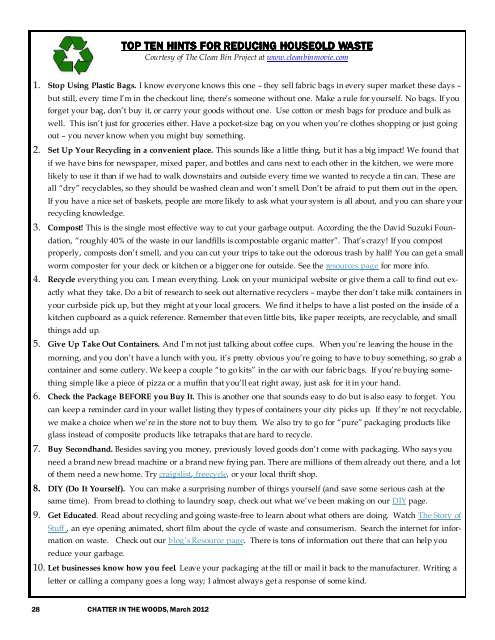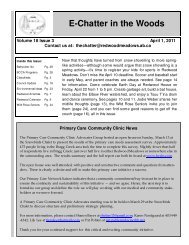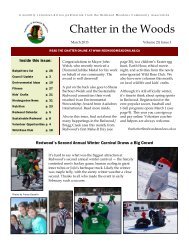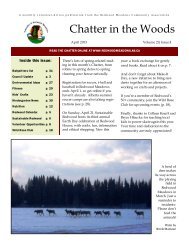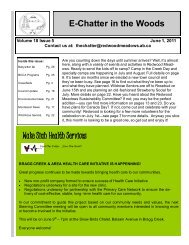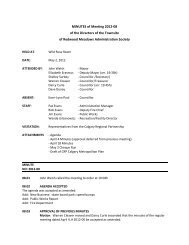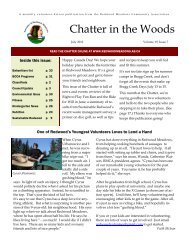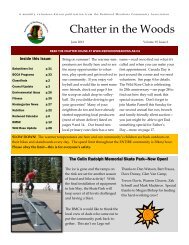March 2012 (PDF) - Townsite of Redwood Meadows
March 2012 (PDF) - Townsite of Redwood Meadows
March 2012 (PDF) - Townsite of Redwood Meadows
You also want an ePaper? Increase the reach of your titles
YUMPU automatically turns print PDFs into web optimized ePapers that Google loves.
TOP TEN HINTS FOR REDUCING HOUSEOLD WASTE<br />
Courtesy <strong>of</strong> The Clean Bin Project at www.cleanbinmovie.com<br />
1. Stop Using Plastic Bags. I know everyone knows this one – they sell fabric bags in every super market these days –<br />
but still, every time I’m in the checkout line, there’s someone without one. Make a rule for yourself. No bags. If you<br />
forget your bag, don’t buy it, or carry your goods without one. Use cotton or mesh bags for produce and bulk as<br />
well. This isn’t just for groceries either. Have a pocket-size bag on you when you’re clothes shopping or just going<br />
out – you never know when you might buy something.<br />
2. Set Up Your Recycling in a convenient place. This sounds like a little thing, but it has a big impact! We found that<br />
if we have bins for newspaper, mixed paper, and bottles and cans next to each other in the kitchen, we were more<br />
likely to use it than if we had to walk downstairs and outside every time we wanted to recycle a tin can. These are<br />
all “dry” recyclables, so they should be washed clean and won’t smell. Don’t be afraid to put them out in the open.<br />
If you have a nice set <strong>of</strong> baskets, people are more likely to ask what your system is all about, and you can share your<br />
recycling knowledge.<br />
3. Compost! This is the single most effective way to cut your garbage output. According the the David Suzuki Foundation,<br />
“roughly 40% <strong>of</strong> the waste in our landfills is compostable organic matter”. That’s crazy! If you compost<br />
properly, composts don’t smell, and you can cut your trips to take out the odorous trash by half! You can get a small<br />
worm composter for your deck or kitchen or a bigger one for outside. See the resources page for more info.<br />
4. Recycle everything you can. I mean everything. Look on your municipal website or give them a call to find out exactly<br />
what they take. Do a bit <strong>of</strong> research to seek out alternative recyclers – maybe ther don’t take milk containers in<br />
your curbside pick up, but they might at your local grocers. We find it helps to have a list posted on the inside <strong>of</strong> a<br />
kitchen cupboard as a quick reference. Remember that even little bits, like paper receipts, are recyclable, and small<br />
things add up.<br />
5. Give Up Take Out Containers. And I’m not just talking about c<strong>of</strong>fee cups. When you’re leaving the house in the<br />
morning, and you don’t have a lunch with you, it’s pretty obvious you’re going to have to buy something, so grab a<br />
container and some cutlery. We keep a couple “to go kits” in the car with our fabric bags. If you’re buying something<br />
simple like a piece <strong>of</strong> pizza or a muffin that you’ll eat right away, just ask for it in your hand.<br />
6. Check the Package BEFORE you Buy It. This is another one that sounds easy to do but is also easy to forget. You<br />
can keep a reminder card in your wallet listing they types <strong>of</strong> containers your city picks up. If they’re not recyclable,<br />
we make a choice when we’re in the store not to buy them. We also try to go for “pure” packaging products like<br />
glass instead <strong>of</strong> composite products like tetrapaks that are hard to recycle.<br />
7. Buy Secondhand. Besides saving you money, previously loved goods don’t come with packaging. Who says you<br />
need a brand new bread machine or a brand new frying pan. There are millions <strong>of</strong> them already out there, and a lot<br />
<strong>of</strong> them need a new home. Try craigslist, freecycle, or your local thrift shop.<br />
8. DIY (Do It Yourself). You can make a surprising number <strong>of</strong> things yourself (and save some serious cash at the<br />
same time). From bread to clothing to laundry soap, check out what we’ve been making on our DIY page.<br />
9. Get Educated. Read about recycling and going waste-free to learn about what others are doing. Watch The Story <strong>of</strong><br />
Stuff , an eye opening animated, short film about the cycle <strong>of</strong> waste and consumerism. Search the internet for information<br />
on waste. Check out our blog’s Resource page. There is tons <strong>of</strong> information out there that can help you<br />
reduce your garbage.<br />
10. Let businesses know how you feel. Leave your packaging at the till or mail it back to the manufacturer. Writing a<br />
letter or calling a company goes a long way; I almost always get a response <strong>of</strong> some kind.<br />
28 CHATTER IN THE WOODS, <strong>March</strong> <strong>2012</strong>


